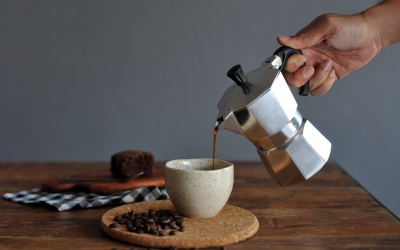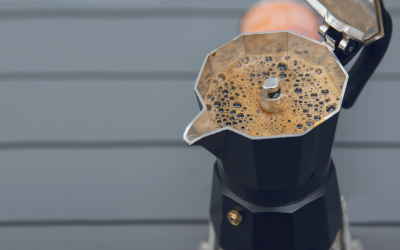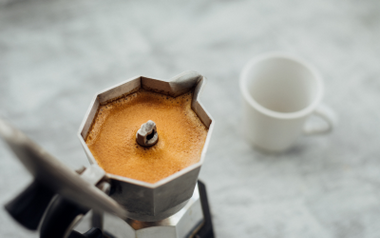Mastering the Art of Stovetop Coffee
Posted by Simone, The Coffee Girl on 22nd Oct 2024
Mastering the Art of Stovetop Coffee: The Road to the Best Coffee at Home
Do you want to brew the best coffee at home? Perhaps you’ve explored various methods but still feel like you’re missing something. Well, it’s time to meet an old friend: the stovetop (Italian) coffee maker. Yes, the one that looks like it could power a tiny steam train. Also known as a Moka pot, this humble device can deliver a rich, espresso-like coffee right from your kitchen stove.
While our paperback book and ebook “How to Brew Coffee” touches on the Italian Stovetop (or Moka Pot) brew method, we thought it worthwhile expanding things a little!
But before you start imagining yourself as an at-home barista extraordinaire, let's discuss the benefits, the potential pitfalls (bubbling over, anyone?), and how to make great coffee every time.

The Benefits of Stovetop Brewing
1. Rich, Flavourful Coffee
One of the primary reasons coffee lovers rave about the stovetop method is the bold, full-bodied coffee it produces. It's like espresso but without the need for a machine that costs as much as a small car. The pressure created by the steam forces water through the coffee grounds, extracting rich oils and flavours that you just don’t get from other methods. Your morning brew will make you feel like you’ve just stepped into a café in Rome.
2. Simplicity
If you've ever felt a bit overwhelmed by coffee gadgets, the stovetop method will be your new best friend. You don’t need to worry about descaling machines, plugging in, or even deciphering digital displays. With a stovetop coffee maker, you need only three things: water, coffee, and heat. It's minimalism at its finest—without the pretentiousness.
3. Affordability
Considering the quality of coffee you can get from a Moka pot, it’s incredibly budget-friendly. No need to place a hefty online coffee order for a fancy brewing machine. This method gives you top-notch coffee without breaking the bank, and it’s a much better investment than, say, buying “organic coffee” from a café every day.
4. Durability
These little coffee makers are built to last. Made of stainless steel or aluminium, a stovetop coffee pot is basically indestructible. You could probably drop it from a cliff (not recommended) and still brew a perfect cup afterward.
5. Small, Portable, and Compact
Need coffee while camping? Traveling? Just visiting your in-laws who somehow survive on instant? The stovetop method can follow you anywhere! It’s compact, easy to pack, and doesn’t need electricity—just a heat source. And unlike those high-tech coffee machines, you won’t be held up by travel bans on liquids. Stovetop coffee makers are lightweight and ready to roll wherever life takes you.

How to Brew the Best Coffee on Your Stove
Now that we’ve established why stovetop coffee is fantastic, let's walk through the brewing process, step by step.
1. Choose Your Coffee Wisely
The best coffee for your Italian Stovetop / Moka pot is a medium to dark roast, finely ground. And don’t forget to always go for organic coffee. And if you're wanting to make sure it’s the absolute best, a quick online coffee order for fresh beans could make all the difference. Don’t forget to try single-origin beans like Sulawesi or Sipi Falls for an adventure in every cup.
2. Add Water to the Bottom Chamber
Fill the lower chamber with water, but not too much! There’s a little safety valve on the side—stop filling before you cover it. And please, use cold water, because nobody wants to start the brewing process prematurely, right?
3. Grind Your Coffee Beans
Be sure to grind right before you use your coffee to get the best taste possible.
For an Italian stovetop coffee maker, the best grind type is a fine grind, but not as fine as espresso. It should resemble the texture of table salt—finer than drip coffee but slightly coarser than espresso grounds.
Using the right grind is essential for this method because:
- Too fine (like espresso) can cause the coffee to become over-extracted, leading to a bitter taste. It can also clog the filter and make it difficult for the water to pass through, increasing the pressure and risk of coffee bubbling over.
- Too coarse (like French press) will result in under-extracted coffee, leading to a weak or watery brew without that rich, bold flavour Moka pots are known for.
Grab a free copy of our Grind Guide online and download it to refer to anytime!
4. Insert Coffee Grounds
Now for the magic! Place your coffee grounds into the filter basket. Level them off (gently, we’re not burying treasure here), but don’t press them down. Let the water do the heavy lifting.
5. Heat It Up!
Place the Moka pot on your stovetop at medium heat. Too hot, and you’ll end up with coffee shooting out like Old Faithful. Too low, and you’ll be standing there forever waiting for it to brew. Pro tip: Make sure the lid is closed—unless you enjoy volcanic coffee explosions. Yes, stovetop coffee can bubble over if left unchecked. This is not one of those “set it and forget it” situations.
6. Listen to Your Coffee
After a few minutes, you’ll hear the gurgling sound that signals the final stage of brewing. Your coffee is almost ready! At this point, remove it from the heat and let the last bit of steam push through. If you leave it on the burner too long, you risk burning your brew—and nobody wants burnt coffee. This might be a great time to work on your "listening skills" (for coffee and life).

Beware of the Bubbles!
Ah, the bubbling over—a rookie mistake. It’s easy to get distracted while waiting for your brew to finish. Maybe you start answering an email or finally make that online coffee order you've been meaning to get to. Next thing you know, coffee’s all over the stovetop, and you’re cleaning up what looks like a science experiment gone wrong.
To avoid this messy fate, keep an eye on your Moka pot and remove it from the heat as soon as you hear that final gurgle. Trust us—this little bit of attentiveness will save you from the tragedy of wasted coffee and avoid a scorched mess.

The Final Sip
For all its simplicity, the stovetop method offers some of the best coffee you can make at home, without the bells and whistles of expensive espresso machines. You get rich, bold flavours and a brewing process that’s as satisfying as the coffee itself.
Remember, it’s all about balance—medium heat, just the right amount of water, and a watchful eye. That way, you can enjoy your perfectly brewed cup without the drama of a bubbling-over disaster. So, whether you're a coffee connoisseur or just someone looking for a better cup at home, give the stovetop method a try.
And hey, while you’re at it, why not place that online coffee order for some fresh organic coffee to really elevate your experience? After all, life's too short for mediocre coffee.
Read more about brewing coffee at home in our EBook “How To Brew Coffee” free with every new coffee subscription, also available as a paperback

